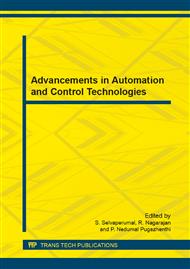p.808
p.814
p.819
p.825
p.830
p.836
p.842
p.848
p.856
Gait Analysis Using Wearable MEMS Tri-Axial Accelerometer System
Abstract:
Walking is an important tool for assessing individual’s health condition. Gait Pattern acquisition and analysis have been carried out using motion capture systems. The limitations of these systems include high cost, indoor monitoring and time consuming setup. Advent of MEMS sensors have overcome the above mentioned limitations. In this work, Wearable Wireless Sensor system has been developed. This system allows acquisition of gait data without intervention for subjects’ natural walking. The Spatio-Temporal parameters were determined for normal and pathological subjects. Results show existence of significant differences in critical phases of pathological gait. Overall degree of flexion / extension is reduced to half in polio gait. The data obtained from this work can be used for the development of subject specific therapeutic methods.
Info:
Periodical:
Pages:
830-835
Citation:
Online since:
June 2014
Authors:
Keywords:
Price:
Сopyright:
© 2014 Trans Tech Publications Ltd. All Rights Reserved
Share:
Citation:


